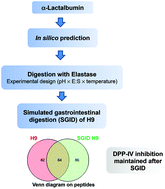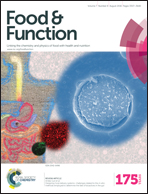Strategies for the release of dipeptidyl peptidase IV (DPP-IV) inhibitory peptides in an enzymatic hydrolyzate of α-lactalbumin†
Abstract
Bovine α-lactalbumin (α-La) contains numerous dipeptidyl peptidase IV (DPP-IV) inhibitory peptide sequences within its primary structure. In silico analysis indicated that the targeted hydrolysis of α-La with elastase should release DPP-IV inhibitory peptides. An α-La isolate was hydrolysed with elastase under different conditions using an experimental design approach incorporating 3 factors (temperature, pH and enzyme to substrate ratio (E : S) ratio) at 2 levels. The hydrolyzate generated at pH 8.5, 50 °C, E : S 2.0% (w/w) (H9) displayed the highest mean DPP-IV inhibition value at 3.1 mg mL−1 of 75.8 ± 3.7% and had a half maximal DPP-IV inhibitory concentration (IC50) value of 1.20 ± 0.12 mg mL−1. Five α-La-derived DPP-IV inhibitory peptides (GY, GL, GI, NY and WL) predicted to be released in silico were identified by liquid-chromatography tandem mass spectrometry (LC-MS/MS) within H9 and its simulated gastrointestinal digestion (SGID) sample. This preliminary study demonstrated the benefit of using a targeted approach combined with an experimental design in the generation of dietary protein hydrolyzates with DPP-IV inhibitory properties.


 Please wait while we load your content...
Please wait while we load your content...